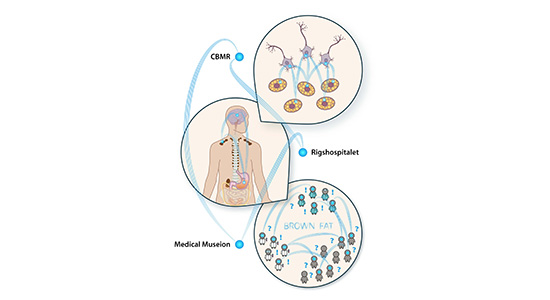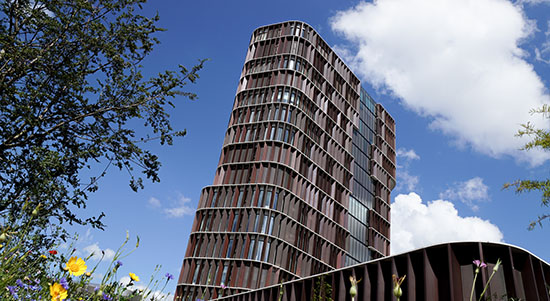
Translational Cell Metabolism in the Schéele Group
The Schéele Group study human brown adipose tissue heterogeneity, inter-cellular and inter-organ crosstalk. From this perspective, the group aims to identify new drug candidates against cardiometabolic disease.

Bottom row (left to right): Sophia Metz, Oliver Haglund, Victor Svenstrup, Camilla Schéele, Alexander Grønning
The Schéele Group investigates the hypothesis that BAT is a regulatory organ in adult human metabolism, which communicates with central and peripheral metabolic units by secreted factors known as batokines. The group investigates the role of these batokines in organ crosstalk, but also as part of a communication network controlling browning by affecting other cells types present in the adipose tissue.
The Schéele group work in close collaboration with clinical departments to analyse otherwise inaccessible human adipose depots. For the next five years, the group will establish a large cohort of perirenal brown adipose tissue samples from patients with a range of cardiometabolic status undergoing kidney surgery.
The group isolates progenitor cells from human adipose tissue biopsies and differentiate them in vitro to study the mechanisms and cellular interactions controlling browning at single cell resolution. They perform joint modelling of multiomics data to identify secreted factors from human brown adipocytes. To prioritize among identified factors, they use machine learning-based software and high-content screening in hIPSc derived cell cultures of for example differentiated into neurons and hepatocytes, with the aim of identifying new drug targets against cardiometabolic diseases.
“Proteomics-Based Comparative Mapping of the Secretomes of Human Brown and White Adipocytes Reveals EPDR1 as a Novel Batokine”
Published in Cell Metabolism in 2019 this study is mapping the secretomes of human brown and white adipocytes and identifies several novel batokines, including EPDR1, exclusively identified in brown adipocytes cell media and necessary for brown fat differentiation.
“A classical brown adipose tissue mRNA signature partly overlaps with brite in the supraclavicular region of adult humans.”
Published in Cell Metabolism in 2013, this study was among the first to provide a molecular characterization of brown fat in adult humans, and furthermore demonstrated that brown fat progenitor cells could be isolated and maintain their brown fat identity when differentiated in vitro.
"Human Brown Adipocyte Thermogenesis Is Driven by β2-AR Stimulation."
Published in Cell Metabolism 2020 this study combined human in vivo experiments, by the group of André Carpentier, with experiments in human brown adipocytes and demonstrated that in humans, brown adipose tissue lipolysis and thermogenesis occur through β2-Adrenergic receptor signaling.
Staff list
| Name | Title | Phone | |
|---|---|---|---|
| Birkedal, Ulf | Guest Researcher | ||
| Gaynor, Taylah Lea | Postdoc | +4535329138 | |
| Grønning, Alexander G Bjørnholt | Researcher | ||
| Haglund, Oliver | PhD Fellow | ||
| Horváth-Rudigier, Carla Petra | External | +4535327045 | |
| Kjeldsen, Maria Pico | Master Student | +4535324327 | |
| Lisdorf, Birgitte Romme | Biomedical Laboratory Scientist | +4535328119 | |
| Metz, Sophia | Postdoc | +4535336653 | |
| Palani, Nagendra Prasad | Researcher | +4535326352 | |
| Pontoppidan, Axel Bergishagen Priem | Research Assistant | ||
| Schéele, Camilla Charlotte Nielsen | Associate Professor - Promotion Programme | +4535330762 | |
| Simoes Heyn Roth Cardoso, Gabriella | Postdoc |





